1991 Brazilian Grand Prix report: Senna wins home race at last
Ayrton Senna wins the 1991 Brazilian Grand Prix, finally seeing F1 victory in front of a home crowd — but only just
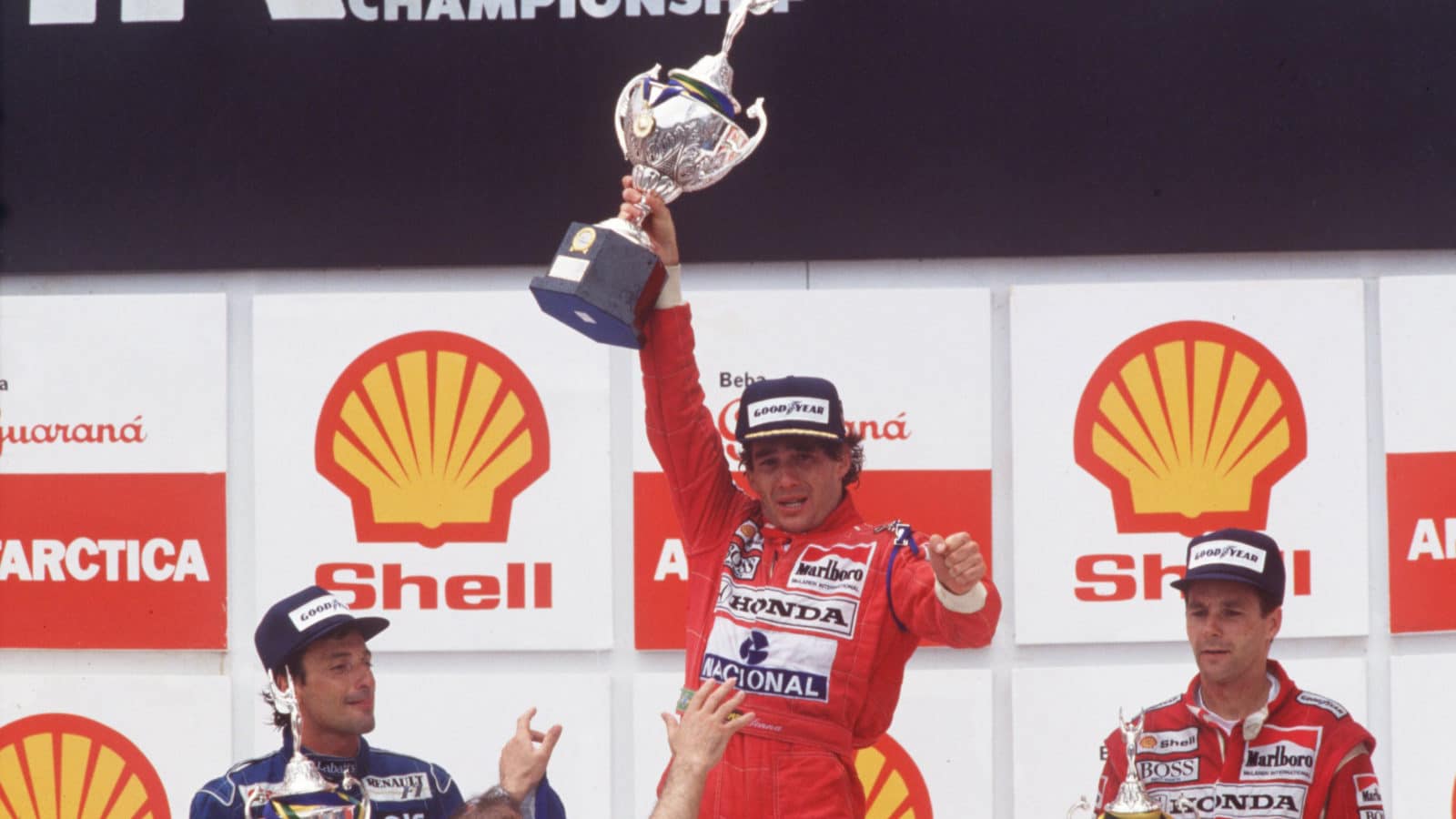
Pascal Rondeau/Getty Images
After the dramatic inflation of recent months, and the manner in which most of them drive on what pass for roads in Sao Paulo, the local populace is used to scrapes and close escapes. Yet 70,000 of them held their breath throughout the closing laps of the Brazilian GP as their idol, Ayrton Senna, performed perhaps the greatest escape of them all. On seven previous occasions the McLaren Honda driver had failed to win his home race. Now, after a flawless performance, leading all the way from pole position, here he was being caught steadily by Riccardo Patrese’s Williams. When Patrese’s teammate Nigel Mansell had been forced to abandon his own challenge when his transmission malfunctioned on lap 60, the Italian had been 40s adrift of Senna, yet the manner in which the gap was diminishing made it clear that even Ayrton was not indulging in a little gamesmanship. He was in trouble.
Interlagos was not Phoenix. In the seasonal opener, to everyone’s surprise and consternation bar McLaren’s, Senna had walked away on a virtuoso demonstration run. If the United States victory had been one of his easiest, however, Brazil was one of the hardest. All weekend it was clear that Williams had made a lot of progress in setting up its FW14s. McLaren had competition.
Ayrton, of course, started from pole. The way things are currently, it might save everyone a lot of time and expense if FISA just reserved it permanently for car number one. For the first 25 laps, however, he was under sustained pressure from Mansell. The Briton, as ever, was in irrepressible form in a car that clearly is a quantum leap over last year’s uninspiring FW13B. True, he had to give best to Patrese in qualifying, something that won’t have pleased him after their near contretemps in Phoenix, but come the race Mansell was always going to be Senna’s principal opponent. Nigel was right in Ayrton’s wheeltracks when he came in on lap 25 for his scheduled tyre stop, but it was an agonisingly slow one as he struggled to find a gear. When he did, he sped back down the pit lane after giving the transmission its second racing start. Any mechanic will tell you, restarts from pit stops are worse because the tyres have literally just come out of the oven and thus have even more grip. The chase was back on.
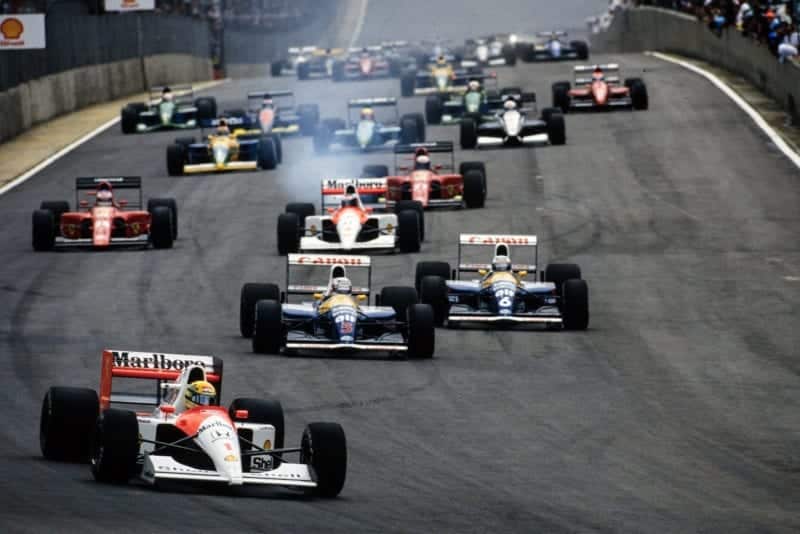
Ayrton Senna leads the field into the first corner
Motorsport Images
After Senna’s demonstration in Phoenix, the F1 circus had been cautious in Interlagos, those outside McLaren worried about the effect over 16 races of a totally superior driver/car combination. Thankfully, Mansell signalled that 1991 will be as hard fought as 1990 with the manner in which he came back at Senna. In Brazil, it was the Williamses that were the best cars, but they did not have the advantage of starting from pole, and as a race leader, there is none better than Senna. He timed his own tyre stop perfectly, and though Mansell reduced the fresh deficit lap by lap, Ayrton didn’t make a single mistake. He felt the MP4/6 was better balanced on its second set of Goodyear Cs, the first having been slightly under inflated. He’d radioed ahead to have the new set’s pressures increased, and the ploy worked. Nevertheless, by lap 42 the gap was back to a mere 2.97s, and at that rate, Mansell would certainly have won, given the problems Senna was to encounter with his gearbox.
He gained a respite, though, as Mansell went rushing pitward again, this time with a cut on the centreline of the right rear. This time the stop took 9.5s, but even then he very nearly collided with the left front man’s jack, such was his haste.
Williams had run its cars with five-speed gearboxes instead of the usual six-speeders used in Phoenix, believing that its problems centred on the shift from fifth to sixth and vice versa, but that ploy failed to work.
In the opening race it was the Didcot cars which had transmission problems. Now, as they experienced them again, the gremlins also struck at McLaren. Twenty laps from the end Senna lost fourth gear. However, the loss came too late for Mansell. A slow downshift one of the problems the team had already experienced on its semi-automatic design threw the FW14 into a spin. After a dramatic, tyre smoking spin turn back into the right direction, Mansell then pulled off to retire. What had gone wrong?
“I went up through the gear in the normal way, from first as far as third,” he said, “but when I got to fourth, it wasn’t there.” Some suggested that four racing starts had ultimately been too much for the transmission.. . .
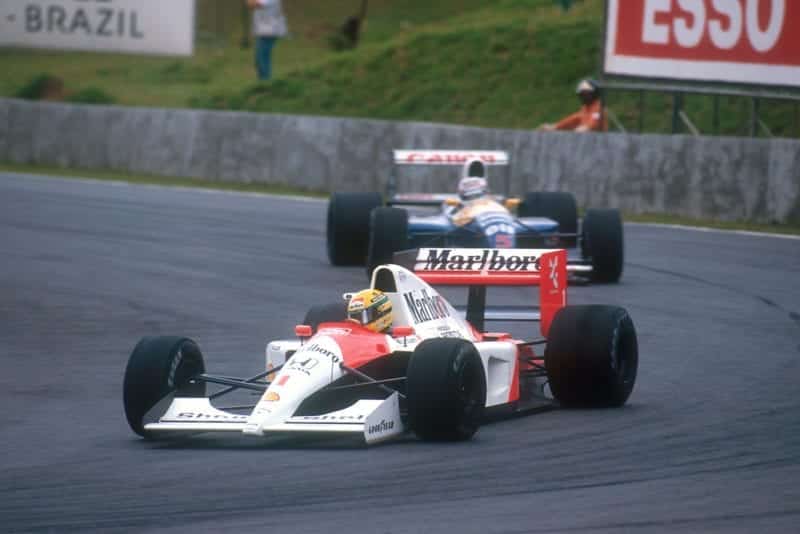
Nigel Mansell shadows Senna’s McLaren
Motorsport Images
Ayrton should then have walked home, the comfortable victor from Patrese even though the track was now slick after light rain. But with only seven laps separating him from the adulation of the crowd, fifth and third gears also disappeared and rather than risk further trouble, he kept the car in sixth. Try keeping your road car in a high gear as long as possible, even in traffic, then imagine that you’re within miles of winning the race that means more to you than any other, and you get a reasonable idea of what Senna had to cope with. From the onboard camera it was clear he was in some sort of trouble, since he wasn’t changing gear. The durable Honda V12 was virtually stalling round the slower corners, and all but skating off as he nursed the brakes and coped without engine braking in the fast ones. Outside the cockpit, however, only McLaren really knew the score. Williams could only guess why he had slowed so much.
From that 40s on lap 60, Riccardo began charging. Ayrton’s lap times went out to 1m 28s as Patrese was consistently in the 1m 21s. His FW14 had been a little imbalanced on its first set, but like Senna’s car, his second batch was better. He was closing, closing,
Yet he too had a problem. Two, in fact. “My car was missing gears at times when I changed down,” he said. And then there was the classic dilemma. “Should I be conservative and try to finish second, or should I push?”
In the end he decided discretion was the better part of six lost points and eased back a fraction, but by the flag he was only 2.99s behind the McLaren. Hindsight would reveal that had he pushed a little harder, he could well have won.
As television viewers saw, Senna stalled just after taking the flag, and was exhausted in the cockpit. It was, he said, the hardest Grand Prix he had driven since he knocked the nose askew on his Toleman in South Africa in 1984, and struggled through for an overheated sixth place and his first World Championship point.
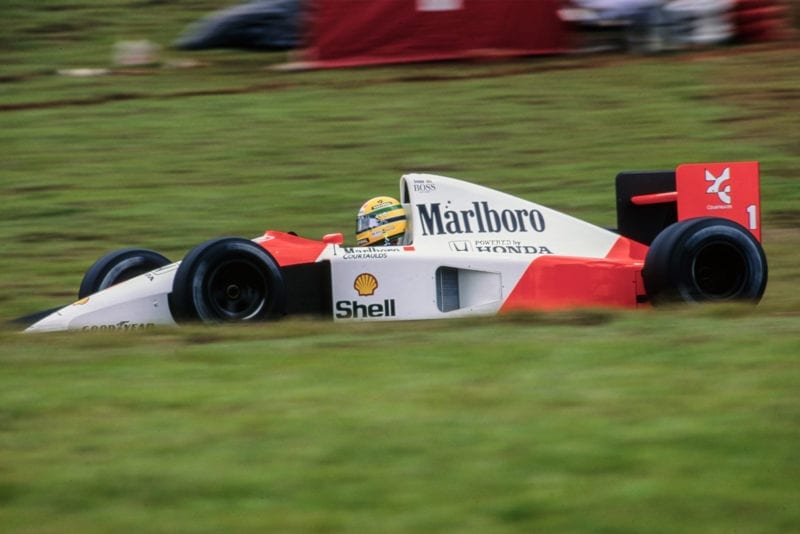
Ayrton Senna in his McLaren leading at Interlagos
“In the closing laps I just had to leave the car in top gear,” he revealed. “The rain didn’t help me, and I was really hoping they’d stop the race. In the slow corners I was pulling only 2000 rpm and the engine was nearly stalling. In the fast corners the car always wanted to push straight on. I saw Patrese coming and didn’t think I would make it, but I felt it was my duty to win here. I pushed the car regardless of the rain, but I was getting cramps and muscle spasms in my upper body. Partly that was because the safety harness was so tight, but also because of emotion! By the finish I had nothing left. God gave me this race.”
For McLaren, then, it was a win that again owed perhaps more to its lead driver than to its car, as was the case at times in 1990. One only had to look at Gerhard Berger’s performance, which ultimately yielded a useful if unspectacular third place, to appreciate that. Senna won Interlagos, not McLaren. But for Senna, one or other of the Williams would have won. It was an interesting point, for while the MP4/6 had been healthy, the FW14 had been its match. Had Mansell’s transmission lasted, or Patrese pushed that little bit more. . . .
If McLaren thus knew it had a fight on its hands after the opening two rounds, and Williams that it had a solid contender, Ferrari was thrown into utter turmoil. By its own admission, it had not expected to go desperately well in Phoenix, since the 642 concept has never really been happy on street tracks. After the opener, however, Prost had counselled caution. “Wait until Interlagos, a circuit that suits us much better. There we will be able to draw better conclusions about our car’s performance.”
Well, the conclusions were drawn all right, but they were negative. Where second place in North America had been acceptable damage limitation, fourth for Prost and sixth for Alesi in South America clearly wasn’t. As in 1990, neither of the cars was particularly quick in qualifying, yet Prost was second only to Mansell in the raceday warm-up. Where did the speed go in the race?

Nelson Piquet is followed by Alain Prost
Motorsport Images
Alain made a poor start, and found himself having an unsuccessful fight with Nelson Piquet’s Benetton. Interestingly, the Ford V8-powered car gave absolutely nothing away to the V12 on either acceleration or top speed, and the Frenchman was the first to stop for fresh Goodyears. It profited him not at all. The Ferraris began to move up towards the middle of the race, as others stopped, but they flattered to deceive. Prost, like Alesi, planned two stops and closed temporarily on Berger after the second, but his bolt was shot. The cars were reasonable on one-lap qualifying-type runs or one-off spurts on full tanks, but ask them to run for any distance, and they lost their edge.
Much was made in some quarters of an alleged front suspension problem, but the design is identical to last year’s. A much more credible suspect was the aerodynamics. Just as McLaren has made obvious strides after hiring former Ferrari air-man Henri Durand, so Ferrari has suffered in the hiatus between his departure and the return of Jean-Claude Migeot, the man responsible for the Tyrrell 019 anhedral nose-look. Meanwhile, team manager Cesare Fiorio’s continual assertions that a new car is imminent have merely served to fuel the internal flames licking round the top management doors at Maranello. There won’t be a new Ferrari this season, but take it as read that some of Migeot’s efforts should be seen at Imola’s race, with more to follow by the French GP in July. The signs from the first races, however, indicate that Ferrari is going to have to come up with something pretty dramatic if it is to regain possession of the ball it dropped so early in the match.
Benetton, like Ferrari, went home pondering what might have been. As in Phoenix, the B190Bs proved highly reliable, and again they could have run non-stop. Both Piquet and Roberto Moreno, however, elected to make stops in Brazil, but neither benefitted to any great extent. “Basically, we were too cautious on our choice of tyre compounds, in both races,” said a team insider. “We went for hard compounds each time, and it turned out that in both races we could have got away with something much softer. Put it down to our relative lack of experience on Pirellis.”
In the closing stages Prost pushed really hard to catch and pass Piquet, as Nelson’s clutch began playing up in the last 20 laps, but the Brazilian felt he could have stayed ahead if he hadn’t had the problem. “Maybe I stopped too late for my fresh tyres,” he admitted further, “otherwise I think I’d have repassed Prost.” He kept ahead of an unhappy Alesi, while Moreno brought his understeering sister car home a lapped seventh.
Much has been expected of the Tyrrell Honda combination, and the much vaunted Stefano Modena, but frankly neither has looked up to much so far. The Italian blotted his copybook with a major shunt in qualifying which wrecked the tub of his 020, and he was chasing vainly after Prost’s seventh-placed Ferrari in the opening stages and being pressed a little by the impressive Bertrand Gachot in Eddie Jordan’s 7-Up 191. Modena’s battle against power understeer ended on lap 20 when the gear linkage broke in the cockpit. With team-mate Satoru Nakajima already out after simply falling off, it was a frustrating weekend for a team that had been expected to run much closer to the front.
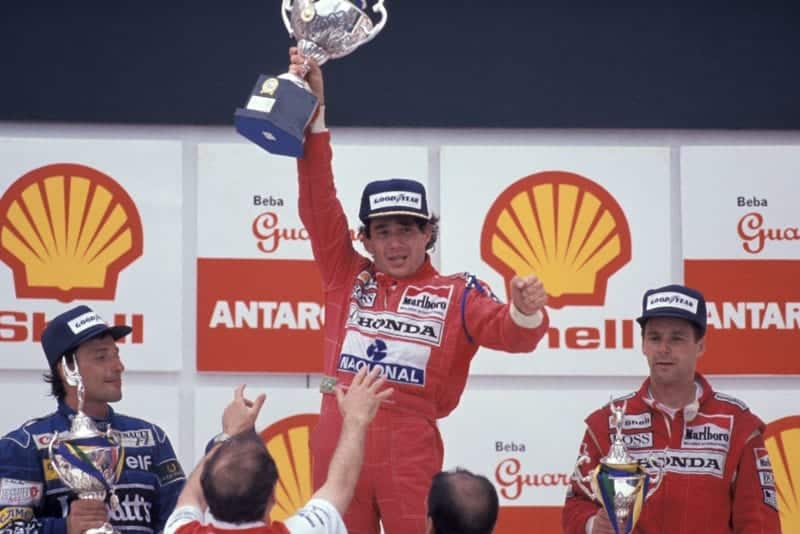
The home favourite struggles to lift his trophy
Motorsport Images
Both Jordans made it through pre-qualifying, and both raced well. Gachot got as high as seventh, just as he had in Phoenix, when what was initially thought to have been a broken exhaust finally took its toll. Subsequent examination indicated that a faulty plug or injector that had caused the 191 to lapse onto seven cylinders, seriously compromising economy in the process.
Andrea de Cesaris had worked up to eighth place behind Gachot at one stage but from lap 17 his Cosworth HB began cutting out intermittently. When it cut altogether four laps later the green car spun into retirement — tearing a hole in its tub and damaging the engine mounts as it slid over a kerb. The Italian had endured a difficult week after flipping a windsurfer and sustaining a nasty leg injury after landing on the keel.
The Dallaras had also pre-qualified with ease, the reliability of their Judd GV V10s again being notable, but just as in Phoenix their qualifying promise went unrewarded. Pirro was nudged out in traffic on the first lap and lost a lot of time having repairs effected, while Lehto dropped back steadily with fading voltage after the alternator drive belt had broken.
Even before the start, drama had claimed Suzuki when Larrousse was unable to start his Lola. The fuel pressure had zeroed, and the blue and red machine was wheeled off the grid. Team-mate Bernard also struggled initially with a fuel pressure-inspired misfire, but his Lola gradually improved and he ran strongly in the top 10 until a clutch hydraulic pipe fractured. Leyton House, too, came away empty handed and embarked on another of its numerous rounds of personnel culling. Both Gugelmin and Capelli showed flashes of promise, but the unlucky Brazilian called it quits after 10 laps, in too much pain from chemical burns sustained after his onboard fire extinguisher had gone off in the cockpit during the morning warm-up. Seven laps later Ivan followed him into retirement with an Ilmor V10 failure, after an energetic charge. For Minardi there was at least consolation for another uncompetitive showing with Morbidelli struggling home eighth, having lost both third and fourth gears in the final laps. Team leader Pierluigi Martini lost ninth place, ahead of him, when he spun on lap 48. Mika Hakkinen again drove an excellent race to pick up a very welcome ninth for Team Lotus, careful in the opening stages such was his anxiety to finish a GP. “I think maybe I could have got Morbidelli, but he was so far ahead there was no point in me overstressing the car,” he admitted. His pace took him ahead of poor old Thierry Boutsen, consigned for 1991 to the role of HGV driver in the awful Ligier JS35. Even Guy thinks it’s another duff car, and fired engineers Claude Galopin and Richard Divila on their return to France to prove it. Comas spun and damaged an oil radiator in his first GP, leaving Boutsen to limp to the finish in an awful state, his car running on 10 cylinders for most of the race after losing its clutch from the 30th lap. To keep him alert, the oil light persisted in blinking for the final 20 laps, while the brakes were as bad as they had been when he had complained of them in the warm-up. It was not a happy Belgian who earned the team its first ’91 finish.

Senna celebrates his home victory in front of his fans
Motorsport Images
After qualifying well poor Gabriele Tarquini hit the wall at the end of the back straight on the first lap, leaving AGS boss Henri Cochin to continue his desperate fight to prolong the team’s life, while the uncomfortable Brundle triumphed in his own way by bringing the Yamaha-powered Brabham home 12th, four laps adrift.
The two Brabhams effectively brought up the rear throughout, with Blundell quite liking his set up, but Brundle hating every moment in a dreadfully cramped cockpit. Blundell ran ahead of him until lap 34, when his engine quit as he was hoping at least to profit from reliability, while Martin was so enervated that he could do only do two or three hard laps before he had to ease up.
As the recovered Senna celebrated a thoroughly deserved 28th GP victory, Goodyear was also busy breaking out the Moet after recording its record 250th GP win. It was fitting, after Richie Ginther had scored the first back in Mexico in 1965 in a Honda, that the Japanese company should take this milestone too.
That the Brazilian performance was no flash in the pan for Williams, however, was underlined early in April when the teams went to the first pre-race test at Imola, for there Patrese was marginally faster than Senna, and Patrick Head came away convinced that the team had identified and eradicated its transmission gremlin. As the various post-mortems were conducted, the new season proper could now begin in earnest.
